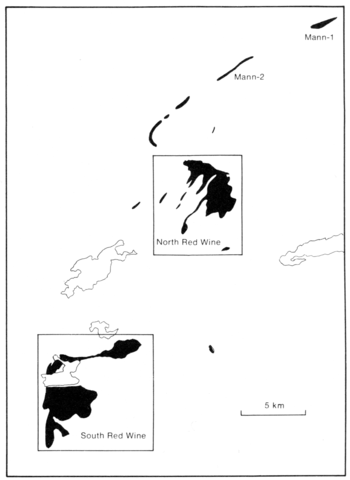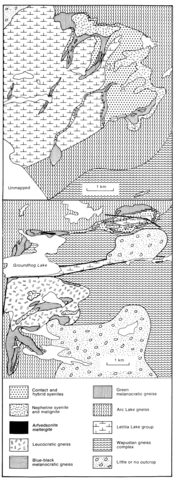stripes
Red Wine is a regionally metamorphosed agpaitic complex situated within the Grenville Front tectonic zone of central Labrador. The complex is concentrated about two centres, the North Red Wine and South Red Wine plutons, but at least eight other lenticles and pods occur in the vicinity, including Mann 1 and Mann 2 which lie to the north (see Fig. 79) and are described here separately (Nos. 155 and 156). The plutons lie between Wapustan gneiss complex (now referred to the Disappointment Lake gneiss - A. Thomas, personal communication, 1983) to the southeast and Seal Lake Group rocks to the northwest. The Letitia Lake Group of metasedimentary and volcanic rocks lying to the west of North Red Wine has been metasomatized with the development of blue amphibole, aegirine, zircon and fluorite. The Arc Lake gneisses which are in contact with much of the North and South Red Wine plutons are augen granitic gneisses which commonly contain aegirine and astrophyllite, and were formed by deformation of peralkaline granite. Both the North and South Red Wine complexes are agpaitic consisting of sinuous to irregular pods of banded gneisses, but relict pods of igneous textured rocks are to be found. The agpaitic rocks have been divided by Curtis and Currie (1981) into six types based on colour and texture, but there is considerable variation within them so that mapped units indicate predominant types. Overall the rocks consist of albite, microcline, perthite, nepheline, arfvedsonite and a variety of alkali pyroxenes, while eudialyte and aenigmatite are usually accessory, although occasionally rock forming minerals. There are a considerable number of relatively rare minerals including lamprophyllite, astrophyllite, ramsayite, karnasurtite and pectolite. The principal rock types are: (1) green melanocratic gneisses composed essentially of aegirine-jadeite and nepheline with minor feldspar and arfdvedsonite; (2) blue-black melanocratic gneiss consisting characteristically of arfvedsonite and nepheline with blue omphacitic pyroxene commonly present, and a wide assemblage of accessory Na-Ti silicates; (3) leucocratic gneiss, which is restricted to South Red Wine, where it forms a large central mass including pods of malignite and nepheline syenite, is the most abundant of the agpaitic rocks covering one third of the known area. The diagnostic mineral assemblage is albite, microcline, arfvedsonite, pyroxene, minor nepheline, and accessory pectolite, aenigmatite, eudialyte, catapleite, fluorite and mica; (4) arfvedsonite melteigite forming small lenses of igneous textured rocks with (1) and (2) above; (5) nepheline syenite and malignite which are coarse to pegmatitic igneous textured rocks forming pods up to 2 km long within North and South Red Wine and as independent bodies in Arc Lake and Wapustan gneiss. They are composed of albite, microcline, nepheline and arfvedsonite; eudialyte is commonly present, locally up to 30%, and aenigmatite occurs in the more mafic varieties. Pectolite, apatite, Ti- ferro-omphacite, aegirine-jadeite and aegirine are accessory and (6) hybrid syenites, which are leucocratic saccharoidal syenites and syenite gneisses, occur sporadically along the margins of both plutons. They consist of albite, microcline perthite, aegirine and a little quartz or nepheline; accessory riebeckite, aenigmatite, eudialyte, fluorite and complex Na-Ti minerals may be present. The hybrid syenites are clearly the result of metasomatism of quartzite (J.Gittins, personal communication, 1984).
The area around Letitia Lake, including the areas of North and South Red Wine, has been mapped recently by Thomas et al. (1983 and A. Thomas, personal communication, 1983) resulting in some small differences in interpretation from those of Curtis and Currie (1981), and the use of the term 'Letitia Lake volcanic complex' to encompass all the alkaline igneous rocks occurring within this area (Hill and Thomas, 1983, Fig. 3). A brief account of this work will be found in Hill and Thomas (1983) as will a description of the relationship between this area and the similar Flowers Bay and Flowers River area (No. 153) some 170 km to the north-northeast.
A description of the minerals is given by Curtis and Currie (1981, p. 23) and a list of 58 identified species, compiled by D. Hogarth, given as Appendix 1 of that paper. A detailed account of the pyroxenes which include aegirine, calcic aegirine, titanium aegirine, aegirine-jadeite and titaniferous ferro-omphacite is given by Curtis and Gittins (1979). Fryer and Edgar (1977) give data for REE on eudialyte-bearing rocks from Red Wine. Modal and chemical analyses of 27 alkaline rocks will be found in Appendix 4 of Curtis and Currie (1981, p. 48) together with 14 analyses of rocks of the Letitia Lake Group, Arc Lake gneisses etc.
BLAXLAND, A.B. and CURTIS, L.W. 1977. Chronology of the Red Wine alkaline province, central Labrador. Canadian Journal of Earth Sciences, 14: 1940-6.
CURRIE, K.L. 1976a. The alkaline rocks of Canada. Bulletin, Geological Survey of Canada, 239: 1-228.
CURTIS, L.W. and CURRIE, K.L. 1981. Geology and petrology of the Red Wine alkaline complex, central Labrador. Bulletin, Geological Survey of Canada, 294: 1-61.
CURTIS, L.W. and GITTINS, J. 1979. Aluminous and titaniferous clinopyroxenes from regionally metamorphosed agpaitic rocks in central Labrador. Journal of Petrology, 20: 165-86.
FRYER, B.J. and EDGAR, A.D. 1977. Significance of rare earth distributions in coexisting minerals of peralkaline undersaturated rocks. Contributions to Mineralogy and Petrology, 61: 35-48.
Gittins, J. personal communication, 1984.
HILL, J.D. and THOMAS, A. 1983. Correlation of two Helikian peralkaline granite-volcanic centres in central Labrador. Canadian Journal of Earth Sciences, 20: 753-63.
THOMAS, A., JACKSON, V. and FINN, G. 1983. Geology, Hope Lake-Disappointment Lake area, Labrador. Department of Mines and Energy, Government of Newfoundland and Labrador, Map 83-32.
Thomas, A. personal communication, 1983.


